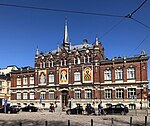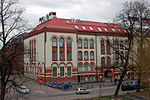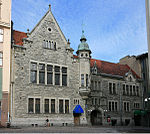Helsinki Burlesque Festival

The Helsinki Burlesque Festival was an annual burlesque festival held in Helsinki, Finland, in late winter every year. The festival was started in 2008 by the Hulapirates Team (Bettie Blackheart, Frank Doggenstein and Kiki Hawaiji). Since 2010, the festival was produced by Bettie Blackheart and Frank Doggenstein from the Helsinki Burlesque organization. The final festival was held in 2017. The festival lasted approximately one week, starting on Friday and ending on Sunday the following week, although not all days had events. The main event was held on Saturday on the second week, and consisted mainly of performances by various burlesque artists. Events were held in: 2008: Restaurant Kaisaniemi, Kaisaniemi, Helsinki 2009: Culture Arena Gloria, Kaartinkaupunki, Helsinki 2010: Culture Arena Gloria, Helsinki 2011: Culture Arena Gloria, Helsinki (29 January - 6 February 2011) 2012: Culture Arena Gloria, Helsinki (10 - 18 February 2012) 2013: Culture Arena Gloria, Helsinki (1 - 2 March 2013) 2014: Culture Arena Gloria, Helsinki (26 February - 2 March 2014) 2015: Culture Arena Gloria, Helsinki (25 February - 1 March 2015) 2016: Culture Arena Gloria, Helsinki (2 - 6 March 2016) 2017: Culture Arena Gloria, Helsinki (3 - 4 March 2017)As well as the main event, the festival also included drawing classes and workshops for aspiring burlesque artists. Related exhibitions are also held around Helsinki.
Excerpt from the Wikipedia article Helsinki Burlesque Festival (License: CC BY-SA 3.0, Authors, Images).Helsinki Burlesque Festival
Pieni Roobertinkatu, Helsinki Kaartinkaupunki (Southern major district)
Geographical coordinates (GPS) Address Website Nearby Places Show on map
Geographical coordinates (GPS)
| Latitude | Longitude |
|---|---|
| N 60.164047222222 ° | E 24.945308333333 ° |
Address
Galleria Laura
Pieni Roobertinkatu 12
00120 Helsinki, Kaartinkaupunki (Southern major district)
Finland
Open on Google Maps











